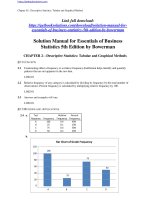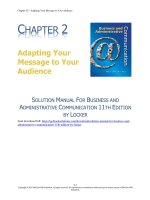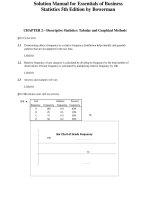Solution manual for essentials of corporate finance 7th edition by ross
Bạn đang xem bản rút gọn của tài liệu. Xem và tải ngay bản đầy đủ của tài liệu tại đây (341.53 KB, 6 trang )
buy this full document at http://testbank.us
Case Solutions
Essentials of Corporate Finance
Ross, Westerfield, and Jordan
7th edition
02/17/2010
Prepared by
Joe Smolira
Belmont University
buy this full document at
buy this full document at http://testbank.us
CHAPTER 1
THE McGEE CAKE COMPANY
1.
The advantages to a LLC are: 1) Reduction of personal liability. A sole proprietor has unlimited
liability, which can include the potential loss of all personal assets. 2) Taxes. Forming an LLC may
mean that more expenses can be considered business expenses and be deducted from the company’s
income. 3) Improved credibility. The business may have increased credibility in the business world
compared to a sole proprietorship 4) Ability to attract investment. Corporations, even LLCs, can
raise capital through the sale of equity. 5) Continuous life. Sole proprietorships have a limited life,
while corporations have a potentially perpetual life. 6) Transfer of ownership. It is easier to transfer
ownership in a corporation through the sale of stock.
The biggest disadvantage is the potential cost, although the cost of forming a LLC can be relatively
small. There are also other potential costs, including more expansive record-keeping.
2.
Forming a corporation has the same advantages as forming a LLC, but the costs are likely to be
higher.
3.
As a small company, changing to a LLC is probably the most advantageous decision at the current
time. If the company grows, and Doc and Lyn are willing to sell more equity ownership, the
company can reorganize as a corporation at a later date. Additionally, forming a LLC is likely to be
less expensive than forming a corporation.
buy this full document at
buy this full document at http://testbank.us
CHAPTER 2
CASH FLOWS AND FINANCIAL
STATEMENTS AT SUNSET BOARDS
Below are the financial statements that you are asked to prepare.
1.
The income statement for each year will look like this:
Sales
Cost of goods sold
Selling & administrative
Depreciation
EBIT
Interest
EBT
Taxes
Net income
Income statement
2009
$277,855
141,641
27,854
39,983
$68,377
8,702
$59,675
11,935
$47,740
2010
$338,688
178,839
36,355
45,192
$78,302
9,962
$68,340
13,668
$54,672
$23,870
23,870
$27,336
27,336
Dividends
Addition to retained earnings
2.
The balance sheet for each year will be:
Cash
Accounts receivable
Inventory
Current assets
Net fixed assets
Total assets
Balance sheet as of Dec. 31, 2009
$20,437
Accounts payable
14,482
Notes payable
30,475
Current liabilities
$65,394
Long-term debt
$176,400
Owners' equity
$241,794
Total liab. & equity
$36,120
16,464
$52,584
$89,040
$100,170
$241,794
In the first year, equity is not given. Therefore, we must calculate equity as a plug variable. Since total
liabilities & equity is equal to total assets, equity can be calculated as:
Equity = $241,794 – 89,040 – 52,854
buy this full document at
CASE 7 C4
Equity = $100,170
Full file at />Ross
Cash
Accounts receivable
Inventory
Current assets
Net fixed assets
Total assets
Balance sheet as of Dec. 31, 2010
$30,880
Accounts payable
18,785
Notes payable
41,821
Current liabilities
$91,486
Long-term debt
$214,184
Owners' equity
$305,670
Total liab. & equity
$40,908
17,976
$58,884
$102,480
$144,306
$305,670
The owner’s equity for 2010 is the beginning of year owner’s equity, plus the addition to retained
earnings, plus the new equity, so:
Equity = $100,170 + 27,336 + 16,800
Equity = $144,306
3. Using the OCF equation:
OCF = EBIT + Depreciation – Taxes
The OCF for each year is:
OCF2009 = $68,377 + 39,983 – 11,935
OCF2009 = $96,425
OCF2010 = $78,302 + 45,192 – 13,668
OCF2010 = $109,826
4. To calculate the cash flow from assets, we need to find the capital spending and change in net
working capital. The capital spending for the year was:
Capital spending
Ending net fixed assets
– Beginning net fixed assets
+ Depreciation
Net capital spending
$214,184
176,400
45,192
$ 82,976
And the change in net working capital was:
Change in net working capital
Ending NWC
– Beginning NWC
Change in NWC
$32,602
12,810
$19,792
CASE 7 C6
So, the cash flow from assets was:
Cash flow from assets
Operating cash flow
– Net capital spending
– Change in NWC
Cash flow from assets
$109,826
82,976
19,792
$ 7,058
5. The cash flow to creditors was:
Cash flow to creditors
Interest paid
– Net new borrowing
Cash flow to creditors
$9,962
13,440
–$3,478
6. The cash flow to stockholders was:
Cash flow to stockholders
Dividends paid
– Net new equity raised
Cash flow to stockholders
$27,336
16,800
$10,536
Answers to questions
1. The firm had positive earnings in an accounting sense (NI > 0) and had positive cash flow from
operations. The firm invested $19,792 in new net working capital and $82,976 in new fixed assets.
The firm gave $7,058 to its stakeholders. It raised $3,478 from bondholders, and paid $10,536 to
stockholders.
2. The expansion plans may be a little risky. The company does have a positive cash flow, but a large
portion of the operating cash flow is already going to capital spending. The company has had to raise
capital from creditors and stockholders for its current operations. So, the expansion plans may be too
aggressive at this time. On the other hand, companies do need capital to grow. Before investing or
loaning the company money, you would want to know where the current capital spending is going,
and why the company is spending so much in this area already.









